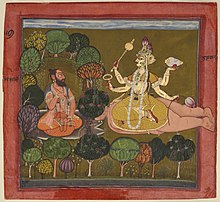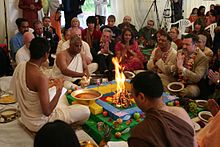
A | B | C | D | E | F | G | H | CH | I | J | K | L | M | N | O | P | Q | R | S | T | U | V | W | X | Y | Z | 0 | 1 | 2 | 3 | 4 | 5 | 6 | 7 | 8 | 9
| Part of a series on |
| Hinduism |
|---|
 |

Brahmin (/ˈbrɑːmɪn/; Sanskrit: ब्राह्मण, romanized: brāhmaṇa) is a varna (caste) within Hindu society. The other three varnas are the Kshatriya, Vaishya, and Shudra.[1][2][3][4][5] The traditional occupation of Brahmins is that of priesthood (purohit, pandit, or pujari) at Hindu temples or at socio-religious ceremonies, and the performing of rite of passage rituals, such as solemnising a wedding with hymns and prayers.[6][7]
Traditionally, Brahmins are accorded the highest ritual status of the four social classes,[8] and they also served as spiritual teachers (guru or acharya). In practice, Indian texts suggest that some Brahmins historically also became agriculturalists, warriors, traders, and had also held other occupations in the Indian subcontinent.[7][8][9]

Origin and history
It seems likely that Kannauj and Middle country was the place of origin of majority of migrating Brahmins throughout the medieval centuries.[10] Coming from Kannauj is a frequent claim among Brahmins of Gujrat in areas distant from Madhyadesha or Ganges heartland.[11]
Generic meaning of the term "Brahmin"

The term Brahmin appears extensively in ancient and medieval Sutras and commentary texts of Buddhism and Jainism.[12] Modern scholars state that such usage of the term Brahmin in ancient texts does not imply a caste, but simply "masters" (experts), guardian, recluse, preacher or guide of any tradition.[13][14][15] An alternate synonym for Brahmin in the Buddhist and other non-Hindu tradition is Mahano.[13]
Patrick Olivelle states that both Buddhist and Brahmanical literature repeatedly define "Brahmin" not in terms of family of birth, but in terms of personal qualities.[16] These virtues and characteristics mirror the values cherished in Hinduism during the Sannyasa stage of life, or the life of renunciation for spiritual pursuits. Brahmins, states Olivelle, were the social class from which most ascetics came.[16] The term Brahmin in Indian texts has also signified someone who is good and virtuous, not just someone of priestly class.[16]
Purusha sukta
The earliest inferred reference to "Brahmin" as a possible social class is in the Rigveda, occurs once, and the hymn is called Purusha Sukta.[17] According to a hymn in Mandala 10, Rigveda 10.90.11-2, Brahmins are described as having emerged from the mouth of Purusha, being that part of the body from which words emerge.[18]
The Purusha Sukta varna verse is now generally considered to have been inserted at a later date into the Vedic text, possibly as a charter myth.[19] Stephanie Jamison and Joel Brereton, a professor of Sanskrit and Religious studies, state, "there is no evidence in the Rigveda for an elaborate, much-subdivided and overarching caste system", and "the varna system seems to be embryonic in the Rigveda and, both then and later, a social ideal rather than a social reality".[19]
According to Vijay Nath, in the Markandeya Purana (250 CE), there are references to Brahmins who were born into the families of Raksasas. He posits that this is an indication that some Brahmins are immigrants and some are also mixed.[20]
Gupta era


According to Abraham Eraly, "Brahmin as a varna hardly had any presence in historical records before the Gupta Empire era" (3rd century to 6th century CE), when Buddhism dominated the land. "No Brahmin, no sacrifice, no ritualistic act of any kind ever, even once, is referred to" in any Indian texts between third century BCE and the late first century CE. He also states that "The absence of literary and material evidence, however, does not mean that Brahmanical culture did not exist at that time, but only that it had no elite patronage and was largely confined to rural folk, and therefore went unrecorded in history".[21] Their role as priests and repository of sacred knowledge, as well as their importance in the practice of Vedic Shrauta rituals, grew during the Gupta Empire era and thereafter.[21]
However, the knowledge about actual history of Brahmins or other varnas of Hinduism in and after the first millennium is fragmentary and preliminary, with little that is from verifiable records or archaeological evidence, and much that is constructed from ahistorical Sanskrit works and fiction. Michael Witzel writes:
Current research in the area is fragmentary. The state of our knowledge of this fundamental subject is preliminary, at best. Most Sanskrit works are a-historic or, at least, not especially interested in presenting a chronological account of India's history. When we actually encounter history, such as in Rajatarangini or in the Gopalavamsavali of Nepal, the texts do not deal with brahmins in great detail.[22]
Gauda and Dravida Brahmins
According to Kalhana's Rajatarangini (12th cent. CE) and Sahyadrikhanda (5th–13th cent. CE) of Skandapurana, Brahmins are broadly classified into two groups based on geography.[23] The northern Pancha Gauda group comprises five Brahmin communities, as mentioned in the text, residing north of the Vindhya mountain range.[23][24] Historically, the Vindhya mountain range formed the southern boundary of the Āryāvarta, the territory of the ancient Indo-Aryan peoples, and Gauda has territorial, ethnographic and linguistic connotations.[25] Linguistically, the term "Gauda" refers to the Sanskrit-derived languages of northern India.[25] The Pancha Gauda Brahmins are:[23]
Subcastes of Gaur Brahmins are:
Subcastes of Kanyakubja Brahmins are:
- Jujhatiya Brahmin[28]
- Saryupareen Brahmin[28]
- Bengali Kulin Brahmin[28]
- Anavil Brahmins[29][30] ( Though they are generally not accepted a Brahmins)
- Khas Brahmins - Nepali Bahuns[28][31]
The Pancha Dravida Brahmins reside to the south of the Vindhya mountain range.[23] The term "Dravida" too has territorial, linguistic and ethnological connotations, referring to southern India, the Dravidian people, and to the Dravidian languages of southern India.[25] The Pancha Dravida Brahmins are:
- Karnataka (Karnataka Brahmins)
- Tailanga (Telugu Brahmins)
- Dravida (Brahmins of Tamil Nadu and Kerala)
- Maharashtraka (Maharashtrian Brahmins)
- Gurjara (Gujarati)[32]
Role in the society
Vedic duties
The Dharmasutra and Dharmashastra texts of Hinduism describe the expectations, duties and role of Brahmins.
According to Kulkarni, the Grhya-sutras state that Yajna, Adhyayana (studying the vedas and teaching), dana pratigraha (accepting and giving gifts) are the "peculiar duties and privileges of brahmins".[33] John Bussanich states that the ethical precepts set for Brahmins, in ancient Indian texts, are similar to Greek virtue-ethics, that "Manu's dharmic Brahmin can be compared to Aristotle's man of practical wisdom",[34] and that "the virtuous Brahmin is not unlike the Platonic-Aristotelian philosopher" with the difference that the latter was not sacerdotal.[35]
The Brahmins were expected to perform all six Vedic duties as opposed to other twice-borns who performed three.
| Adhyayan (Study Vedas) |
Yajana (performing sacrifice for one's own benefit) |
Dana (Giving Gifts) |
Adhyapana (Teaching Vedas) |
Yaajana (Acting as Priest for sacrifice) |
Pratigraha (accepting gifts) | |
|---|---|---|---|---|---|---|
| Brahmin | ✓ | ✓ | ✓ | ✓ | ✓ | ✓ |
| Kshatriya | ✓ | ✓ | ✓ | No | No | No |
| Vaishya | ✓ | ✓ | Zdroj:https://en.wikipedia.org?pojem=Brahmin_communities








